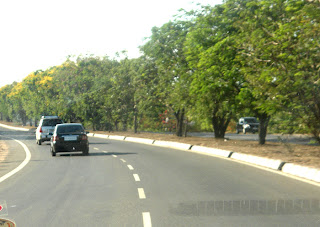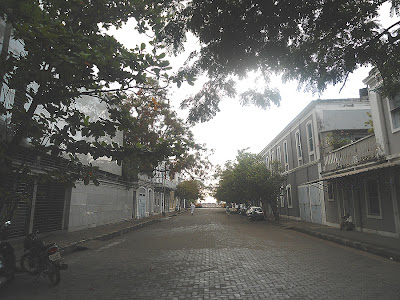Place:
PONDICHERRY
One of the most popular destinations of the Coromandel coast, and indeed south India,
Pondicherry is a charmed, quaint town, steeped in French culture topped by Sri Aurobindo's aura. A visit indicated all of this to be true, but not reflecting a true picture. It is as much a Tamil Nadu small town, congested and colourful in a way only towns in that area can be. The city actually almost looks away from the Bay of Bengal.
 |
| NH 32 is an excellent way to reach Pondicherry from Chennai |
I drove in from Madras, now Chennai, starting around 7 in the morning. The approximately 150 kilometre journey takes a little over two hours, unless you are stuck in a jam, as I was. I made full use of it by sleeping through, and reached in about four hours! The road, NH 32, is excellent though, and very noticeable to north Indian eyes. Small towns with their colourful temple mandapams and crowded markets dot the journey, with green- brown hills and pretty vibrant fields replacing them once you are out of the urban areas. To me, it is surprising that at coastal route is not more popular, but the driver said that road was not as good.
 |
| The entry gate to Pondicherry |
Eagerly looking out as I entered the city, as I had heard so much about it, the first moments inside were disappointing. Instead of beautiful French era mansions, on view narrow streets flanked by small street side shops, interspersed by modern glass fronted facades of new hospitals and coaching institutes. :( There is no effort to cash into the reputation of the town, and the disappointment continued till suddenly the very look of the place altered. I was later told Pondicherry, officially Puducherry, is divided into what is now the heritage zone, or White Town and the rest, referred to as Black Town.
White Town
So today, when people gush about Pondicherry, they refer usually only to the White Town and Auroville, an outpost. The White Town, built by the French who were in charge for about 280 years, fronts one of the four beaches of the territory, is an approximately oval area laid out in a grid pattern within, with buildings and parks.
 |
| Explore White Town on foot, and let the camera capture little details |
This French quarter has cousins across the world, and does not compare favourably either in the architecture or in its upkeep, even though the tourism office is right by the sea and quite disappointing. Though it is best explored on foot, be ready to be tired as the weather is muggy for the better part of the year. Also many streets are cobbled, great to look at, but not made for long walks. The architectural style is largely French colonial, part Gothic, with some local influences.
The
beachfront area, known as Promenade beach, is well used. Early morning sees joggers out in force, even in light rain, while students take up the later morning time by running around and playing. Gandhi's statue is a favourite hangout. Quiet during the afternoons, the day evening belongs to the tourists and towners who may come for the sea breeze or just a walk. There is an old lighthouse, which was visible from the room of the hotel I was staying in, and badly in need of repair.
White Town has a number of beautiful
mansions, though many now house Indian officialdom and bureaucracy. A significant part is still private however, and keep a lookout for the Alliance Française, Lycée Française, French Institute, Mairie (Town hall). The area has a number of hotels, many of whom have tried to recreate the past including Hotel D’orient and Duplex. There are a number of
museums, including the Pondicherry Museum, the former houses of writers Bharathidasan and Subramania Bharathi, which are today museums and the Jawahar Toy Museum. If you are on a short trip, enjoy the outdoors instead.
 |
| The Park Monument, set in the middle of the park, and left, scenes of devastation from the cyclone are still visible |
Pondicherry was devastated by a
cyclone in December 2011, and signs of the extensive devastation can still be seen around the town. A prominent park, today called Bharati Park, still has uprooted trees, as do a peripheral parts of the town.
A special feature of the town is its rich
craft heritage. There are a number of excellent craft labels, and at least one label, Hidesign is now an internationally acclaimed leather accessories brand. But there are many more, and for a craft lover, a visit to the main market in White Town or in Auroville is going to throw time budgeting astray. Look out for Maroma. For the budget conscious, try Auroshikha. Must buys include perfumed candles, kurtas, 'green' bags, soaps, oils and incense sticks. Besides great baked products, especially from Auroville. Quirky shapes, sizes and aromas ensure they make for great gifts. Plan accordingly.
 |
| The Matri Mandir is situated in the middle of the Peace area |
Especially when visiting
Auroville. Arguably the most famous extension of Pondicherry, this is where an alternate future is taking shape. For more on it, look up the net, but for the average visitor, this is paradise for those yearning to get away from the tempo of busy urban lives.
Founded by The Mother, Sri Aurobindo's disciple in 1968, it is an UNESCO endorsed township that is worth a visit, if only to see white skinned people zipping around in bikes, usually attired in calico lungis or kurtas, complete with checks. Its beautiful, un-manicured environs (you get the drift), tucked away houses, lawns and gardens merging into woods, dirt tracks and the occasional road, small markets, the monumental Matri Mandir and the charming food and craft outlets, all make it a a 'different' trip. You have to buy peanut butter from the bakery. Just a word of caution, if you wish to visit Matri Mandir, you will have to get prior permission from the Visitor's Centre, which is quite far away. If you can, spend a day there, and a sense of peace, however ephemeral, is sure to envelop you. It was my last stop at the former French outpost, and a great way to conclude the trip.







No comments:
Post a Comment